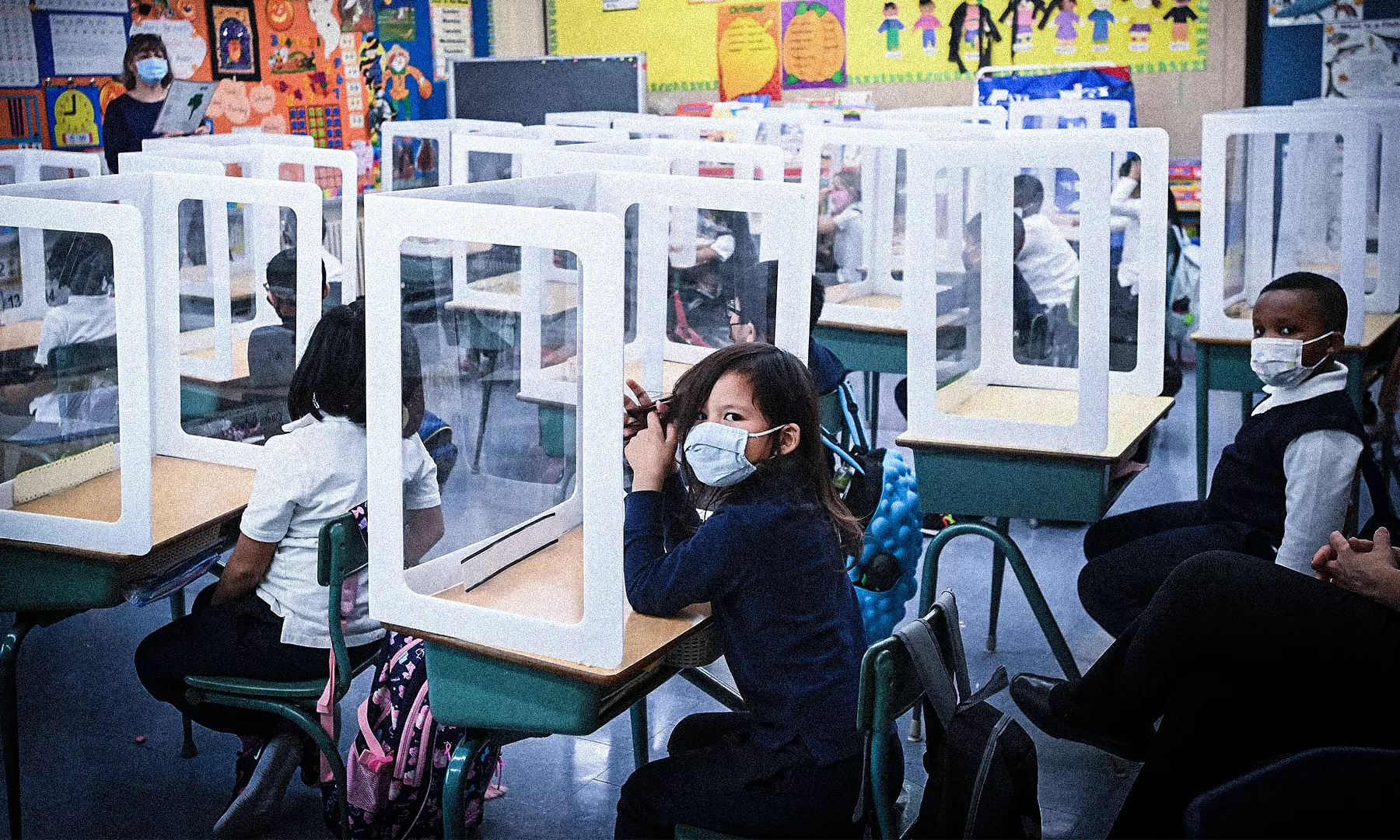Privatization in public education began well before the COVID-19 pandemic in Canada. Nevertheless, since the beginning of the pandemic, trends of creeping privatization and marketization in public education have emerged across Western Canada, including Alberta, British Columbia, Manitoba, and Saskatchewan. Because education is primarily a provincial responsibility in Canada, territorial borders can hide the common tactics and consequences used to undermine public education and advance privatization. As well, the differing contexts of each province, including past policies, governing parties, and impending elections, have shaped the ways privatization has unfolded.
Despite these factors, education privatization has occurred in comparable ways in the four Western Canadian provinces since the outset of the pandemic, and understanding these trends is an essential part in resisting this movement.
When examining how privatization has crept into the four provinces from March 2020 to December 2023, we considered both exogenous and endogenous privatization. Exogenous privatization is where the private sector takes on roles within public schools that once were a public responsibility, and endogenous privatization is where practices and values from the for-profit sector are adopted within public education (Ball & Youdell, 2007). Exogenous privatization includes new or changed roles for businesses, parents, and not-for-profits within schools, as well as the increase of private methods for school funding, such as fees, fundraising and more. Endogenous privatization includes the increase in policies relating to school choice, marketization and other for-profit values or practices.
Both types of privatization are at play, and several trends are noticeable in the four provinces: reduced public school funding and increased investment in independent schools, new policies in support of independent schools, an increase in alternative sources of funding for public schools, and a focus on for-profit values and practices in the public system.
Of the four provinces, trends in Manitoba, Saskatchewan, and Alberta most closely mirror each other. For most of the pandemic period, these provinces were governed by conservative parties while British Columbia was governed by a left of center party. While these privatization trends are most prominent in the first three provinces, there are notable similarities across all four provinces.
Reduced public school funding and increased investment in independent schools
The general trend across the Western provinces was a reduction in funding for public schools, a trend that in some cases existed prior to the pandemic. For instance, in Manitoba the provincial government under the Progressive Conservatives increased education funding at less than the rate of inflation from 2016 to 2022, resulting in de facto decreases over time. Similar critiques have been made in Saskatchewan and Alberta, where education funding increases have in recent years periodically failed to meet the rate of inflation. Manitoba took this defunding a step farther in 2023 when the provincial government stopped school boards from raising property taxes and penalized a school division that raised taxes to cover insufficient funding (Macintosh, 2023). This defunding of public schools is one means of destabilizing public systems.
In this same period, increased investment in independent (private) schools was persistent. In British Columbia, independent schools received $491 million in public funding and subsidies in the 2022-23 school year, which is twice as much as in 2000 (Hemingway, 2022). While the governing Saskatchewan Party increased public school funding by 2.5 percent in 2023, which was lower than the rate of inflation of 5 percent, independent schools received a 23 percent increase in funding. In Alberta, the United Conservative Party (UCP), elected to a majority government in 2019, took a more active role in supporting independent and charter schools.
In 2020, the Alberta government updated their funding model to use a three-year weighted enrollment average to allocate funds, which resulted in lower school funding grants in many cases. However, new schools were given financial assistance. This new assistance coincided with the lifting of the charter school cap, thus encouraging the establishment of new charter schools. In 2020, $75 million was also given to expand charters in Alberta. This increased investment in independent and charter schools demonstrates a disparity in financial support between the public and private systems across the Western provinces.
Deregulation for privatization: independent, charter, and home schools
In some provinces, independent schools received increased support through legislation and policy changes. Alberta provided the strongest example. In 2020, the Choice in Education Act was passed. This legislation allowed people to apply directly to the provincial government to create charter schools, in an effort to increase the number of charters across the province. The Choice in Education Act also formally recognized the importance of independent schools and reduced supervision of homeschooling families.
In 2022, the Red Tape Reduction Act was passed, which reduced oversight relating to private revenue for independent schools and other organizations. Critics have voiced concerns that this means reduced transparency for the funding of independent schools (Bellefontaine, 2022). Finally, the province started a kindergarten home education pilot program in the 2023-24 school year, actively promoting increased enrollment in homeschools for their youngest students. These policy changes signal the overwhelming support the governing UCP has for homeschooling, independent, and charter schools.
Similarly, in 2022, the Saskatchewan government under the Saskatchewan Party introduced a new category of Certified Independent School, which received 75 percent of the average per student rate. This change provided a step between Qualified Independent Schools, which receive 50 percent of the per student funding for schools up to 399 students, and Associate Schools. The goal of this change was to allow for continued growth of independent schools.
These policies that strengthen education privatization are striking, particularly considering the underfunding of the public system that hampered their ability to compete within this marketized education system.
Increasing reliance on the alternative privatized sources of funding
Due to the financial constraints imposed by provincial governments, public schools across Western Canada have been forced to pursue other sources of funding by increasing fees, engaging in fundraising, grant writing and soliciting philanthropy.
These tactics are not new. In Alberta some school divisions continued to rely on pre-existing charitable trusts. For instance, Edmonton Public Schools routinely raise money for programs or supplies that fall outside of the government’s public funding, such as full day kindergarten, nutrition programs, mental wellness, enrichment, and technology. In Manitoba, Winnipeg School Division continues the practice of fundraising via individual schools and endowment funds and continues to rely on philanthropy to cover shortfalls. In British Columbia, Surrey School Division was a registered charity prior to the pandemic. It has a designated department that facilitates donations of money, services, and goods, plus the development of partnerships. Donations to this charity increased from 2019 to 2023.
In other provinces, charitable foundations became more prominent after the pandemic. Increased reliance on fundraising and donations was evident in Saskatchewan since the start of the pandemic. For example, the Living Sky School Division launched an Innovation Fund in 2023 meant to support programming like nutrition programs or outdoor learning resources (Kurz, 2023). Donations to the charitable foundation for Saskatoon Public Schools increased substantially compared to pre-pandemic, with the foundation raising enough money to fund full day kindergarten.
Increased school fees were also a problem in several provinces. In 2023, the Winnipeg School Division in Manitoba increased fees for summer courses. In 2019, Alberta reversed rules on fees, which opened the door for new school fees to be introduced in subsequent years. In 2023, school fees increased in various public schools across Saskatchewan. Premier Scott Moe urged school divisions to draw from reserve funds, even though these were non-existent in many school divisions (Vescera, 2022). While the increase in school fees was often contentious, it was viewed as a necessary means to overcome insufficient public funding.
However, while increased fees and fundraising are often positioned as a solution to underfunding, these alternate funding methods work to erode public systems and legitimize education privatization.
New roles expanding for private actors
As public school systems worked to overcome underfunding, new roles emerged for private actors. In the four Western provinces, provincial governments partnered with the private sector and non-profits to deliver programming, particularly relating to financial literacy, job skills, career development, and technology. For instance, Manitoba turned to the private sector to hire curriculum consultants and to report on remote learning strategies. The provincial government under the PCs also chose to pursue several public-private partnerships, particularly a plan announced in 2023 to build nine new schools using P3 agreements (Lambert, 2023). People for Public Education was among the many voices advocating against this plan, and it was later abandoned after the election of the New Democratic Party (NDP) government in October 2023.
Affirming for-profit values and practices in the public school systems
Considering the participation of private actors in delivering financial literacy and job skills programming, it is not surprising that for-profit values and practices were emphasized in other areas of the school system. In some cases, these values were already firmly entrenched. In British Columbia, there is a long history of for-profit values and practices in schools. As a result, there remained a focus on generating revenue in schools in British Columbia during the pandemic period. In Alberta, the prominent support for choice in education that emerged after the 2019 provincial election continued previous policies promoting school choice.
Other for-profit values emerged during this period. Both Manitoba and Saskatchewan introduced Teacher Idea or Innovation Funds, where teachers competed for grant money to fund innovative projects. In our province of Manitoba, the Teacher Idea Fund included a competition for grant funding for mental health related projects. This was frustrating for educators who were told to compete for funding while witnessing the widespread mental health impacts of pandemic schooling.
Manitoba also made the biggest foray into pursuing for-profit values in education from 2019 to 2023, as the government pushed for education reforms focused on accountability, standardization, improving achievement, and consolidating governance structures through Bill 64: The Education Modernization Act. These proposed reforms would have eliminated public school boards and introduced other changes aimed at improving accountability. While these changes would have integrated for-profit values into the school system, they were met with significant resistance and were ultimately withdrawn.
Conclusion and looking ahead
While schools were increasingly strained by the COVID-19 pandemic, privatization and marketization continued and to some extent expanded during the pandemic period in education. This included inadequate public funding, the pursuit of privatized sources of funding, increased support for independent schools, expanded involvement of private actors and the affirmation of for-profit values. Resistance to these elements of privatization also arose in various provincial contexts. In Manitoba, Bill 64 was met with resistance from established organizations and new grassroots groups, unions and other community members. In 2023, the PC government of Manitoba was defeated by the NDP, and many privatization projects were ended, such as the rejection of public-private partnerships for the construction of new schools. During the pandemic period in Manitoba, education was a battleground where pre-existing and grassroots groups protested education privatization.
In other provinces, community groups continued to push back against creeping privatization. This included SOS Alberta, who worked to question the UCP’s dedication to school choice amidst chronic underfunding. The Saskatchewan Teachers’ Federation advocated on behalf of teachers, but also for robustly funded and inclusive public systems. In British Columbia, the Institute for Public Education continued to advocate for a strong public education system in BC and beyond. More recently, the Public Education Exchange built connections across provinces to better understand privatization and marketization in education in Canada and to communicate the dangers these pose.
While education privatization is a growing threat to strong public systems, we are optimistic that by better understanding how these trends are playing out in different provincial contexts, a cross-border response is possible to advocate on behalf of a strong public education system.
The authors are all educators in Manitoba. They are founding members of the advocacy groups People for Public Education, Manitoba, and are affiliated with The Public Education Exchange (PEX) network.


